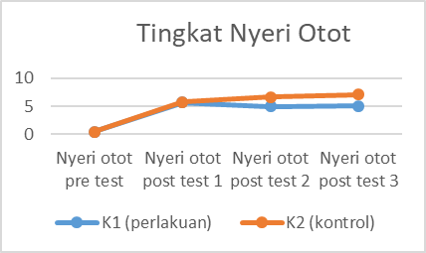Pengaruh Pemberian Kurkumin Dalam Meringankan Gejala Delayed Onset Muscle Soreness (DOMS) Setelah Aktivitas Eksentrik
Abstract
Delayed Onset Muscle Soreness (DOMS) adalah ketidak nyaman atau nyeri pada otot yang terjadi setelah latihan dan pada umumnya disebabkan oleh latihan yang didominasi oleh kontraksi eksentrik. DOMS biasanya disertai dengan gejala-gejala seperti kekakuan, penurunan pada kekuatan otot serta nyeri yang dirasa 12-24 jam setelah latihan dan mencapai puncaknya pada 24-48 jam setelah latihan. Tujuan dari penelitian ini adalah mempercepat pemulihan DOMS dengan mengetahui pengaruh pemberian kurkumin dalam meringankan gejala DOMS setelah latihan eksentrik. Gejala DOMS yang diukur pada penelitian ini adalah nyeri otot. Desain penelitian ini adalah randomized group pretest and posttest design. Subjek penelitian ini adalah mahasiswa PJKR IKIP Budi Utomo yang dibagi secara acak ke dalam 2 kelompok, 18 orang coba kelompok kontrol (K1) dan 18 orang coba kelompok perlakuan (K2). Kurkumin diberikan secara oral dalam bentuk kapsul setelah aktivitas eksentrik dengan dosis 150 mg. Pemberian kurkumin dilakukan 1 jam dan 24 jam setelah aktivitas eksentrik. Nyeri otot diukur dengan Visual Analogue Scale. Pengukuran dilakukan 1, 24 dan 48 jam (selama 3 hari) setelah aktivitas eksentrik. Dari hasil penelitian diketahui bahwa pemberian kurkumin pada kelompok perlakuan dapat menurunkan nyeri otot pada 48 jam setelah aktivitas eksentrik (5,08,3±0,79) jika dibandingkan dengan kelompok kontrol dengan nilai p=0,00 (p<0,05).
Downloads
References
Astuti, A. D. W., & Murbawani, E. A. (2011). Efektivitas Pemberian Ekstrak Jahe Merah ( Zingiber officinale roscoe varr Rubrum ) dalam Mengurangi Nyeri Otot pada Atlet. Artikel Penelitian Program Studi Ilmu Gizi Fakultas Kedokteran Universitas Diponegoro, 1–29. http://eprints.undip.ac.id/32557/1/381_Ambar_Dwi_Widhi_Astuti_G2C007006.pdf
Breivik, H., Borchgrevink, P. C., Allen, S. M., Rosseland, L. A., Romundstad, L., Breivik Hals, E. K., Kvarstein, G., & Stubhaug, A. (2008). Assessment of pain. British Journal of Anaesthesia, 101(1), 17–24. https://doi.org/10.1093/bja/aen103
Contrò, V., Mancuso, E., & Proia, P. (2016). Delayed onset muscle soreness (DOMS) management: present state of the art. Trends in Sport Sciences, 23(3), 121–127.
Davis, J. M., Murphy, E. A., Carmichael, M. D., Zielinski, M. R., Groschwitz, C. M., Brown, A. S., Gangemi, J. D., Ghaffar, A., & Mayer, E. P. (2007). Curcumin effects on inflammation and performance recovery following eccentric exercise-induced muscle damage. American Journal of Physiology - Regulatory Integrative and Comparative Physiology, 292(6), 2168–2173. https://doi.org/10.1152/ajpregu.00858.2006
Di Pierro, F., Rapacioli, G., Di Maio, E. A., Appendino, G., Franceschi, F., & Togni, S. (2013). Comparative evaluation of the pain-relieving properties of a lecithinized formulation of curcumin (Meriva®), nimesulide, and acetaminophen. Journal of Pain Research, 6, 201–205. https://doi.org/10.2147/JPR.S42184
Drobnic, F., Riera, J., Appendino, G., Togni, S., Franceschi, F., Valle, X., Pons, A., & Tur, J. (2014). reduction of delayed muscle soreness- cucurmin-A.Elliott. Journal of the International Society of Sports Nutrition, 11, 1–10.
Eston, R., Byrne, C., & Twist, C. (2004). Muscle function after exercise-induced muscle damage: Considerations for athletic performance in children and adults. Journal of Exercise Science and Fitness, 1(2), 85–96.
Gupta, S. C., Patchva, S., & Aggarwal, B. B. (2013). Therapeutic roles of curcumin: Lessons learned from clinical trials. AAPS Journal, 15(1), 195–218. https://doi.org/10.1208/s12248-012-9432-8
Hawker, G. A., Mian, S., Kendzerska, T., & French, M. (2011). Measures of adult pain: Visual Analog Scale for Pain (VAS Pain), Numeric Rating Scale for Pain (NRS Pain), McGill Pain Questionnaire (MPQ), Short-Form McGill Pain Questionnaire (SF-MPQ), Chronic Pain Grade Scale (CPGS), Short Form-36 Bodily Pain Scale (SF. Arthritis Care and Research, 63(SUPPL. 11), 240–252. https://doi.org/10.1002/acr.20543
Kim, J., & Lee, J. (2014). A review of nutritional intervention on delayed onset muscle soreness. Part I. Journal of Exercise Rehabilitation, 10(6), 349–356. https://doi.org/10.12965/jer.140179
Kuehl, K. S., Perrier, E. T., Elliot, D. L., & Chesnutt, J. C. (2010). Efficacy of tart cherry juice in reducing muscle pain during running: A randomized controlled trial. Journal of the International Society of Sports Nutrition, 7, 1–6. https://doi.org/10.1186/1550-2783-7-17
Mallard, A. R., Briskey, D., Richards, BExSSc, A., & Rao, A. (2020). Curcumin Improves Delayed Onset Muscle Soreness and Postexercise Lactate Accumulation. Journal of Dietary Supplements, 0(0), 1–12. https://doi.org/10.1080/19390211.2020.1796885
McFarlin, B. K., Venable, A. S., Henning, A. L., Sampson, J. N. B., Pennel, K., Vingren, J. L., & Hill, D. W. (2016). Reduced inflammatory and muscle damage biomarkers following oral supplementation with bioavailable curcumin. BBA Clinical, 5, 72–78. https://doi.org/10.1016/j.bbacli.2016.02.003
Nakhostin-Roohi, B., Nasirvand Moradlou, A., Mahmoodi Hamidabad, S., & Ghanivand, B. (2016). The Effect of Curcumin Supplementation on Selected Markers of Delayed Onset Muscle Soreness (DOMS). Annals of Applied Sport Science, 4(2), 25–31. https://doi.org/10.18869/acadpub.aassjournal.4.2.25
Nicol, L. M., Rowlands, D. S., Fazakerly, R., & Kellett, J. (2015). Curcumin supplementation likely attenuates delayed onset muscle soreness (DOMS). European Journal of Applied Physiology, 115(8), 1769–1777. https://doi.org/10.1007/s00421-015-3152-6
Noorafshan, A., & Ashkani-Esfahani, S. (2013). A Review of Therapeutic Effects of Curcumin. Current Pharmaceutical Design, 19(11), 2032–2046. https://doi.org/10.2174/1381612811319110006
Pearcey, G. E. P., Bradbury-Squires, D. J., Kawamoto, J. E., Drinkwater, E. J., Behm, D. G., & Button, D. C. (2015). Foam rolling for delayed-onset muscle soreness and recovery of dynamic performance measures. Journal of Athletic Training, 50(1), 5–13. https://doi.org/10.4085/1062-6050-50.1.01
Rakasiwi, A. M. (2014). Aplikasi Ice Massage Sesudah Pelatihan Lebih Baik Ice Massage Pada Otot Hamstring. Jakarta : Universitas Esa Unggul, 14(April). http://id.portalgaruda.org/?ref=browse&mod=viewjournal&journal=4571
Roihatul Mutiah. (2015). EVIDENCE BASED KURKUMIN DARI TANAMAN KUNYIT (Curcuma longa) SEBAGAI TERAPI KANKER PADA PENGOBATAN MODERN. Jurnal Farma Sains, 1(1), 28–41.
Szymanski, D. J. (2001). Recommendations for the Avoidance of Delayed-Onset Muscle Soreness. Strength and Conditioning Journal, 23(4), 7–13. https://doi.org/10.1519/00126548-200108000-00001
Tanabe, Y., Maeda, S., Akazawa, N., Zempo-Miyaki, A., Choi, Y., Ra, S. G., Imaizumi, A., Otsuka, Y., & Nosaka, K. (2015). Attenuation of indirect markers of eccentric exercise-induced muscle damage by curcumin. European Journal of Applied Physiology, 115(9), 1949–1957. https://doi.org/10.1007/s00421-015-3170-4
Zondi, P. C., Janse van Rensburg, D. C., Grant, C. C., & Jansen van Rensburg, A. (2015). Delayed onset muscle soreness: No pain, no gain? The truth behind this adage. South African Family Practice, 57(3), 29–33. https://doi.org/10.4102/safp.v57i3.4148




